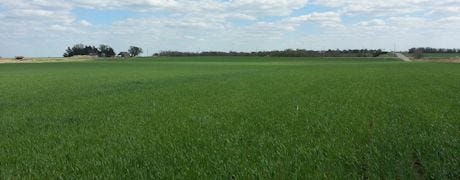
Day two of the 2014 Winter Wheat Tour wrapped up in Wichita after 22 cars visited 271 wheat fields across western and southern Kansas, and northern Oklahoma.
Yield calculations varied significantly even within the same region, but gradually increased moving east. Despite experiencing late freeze earlier this month, drought is considered the biggest concern.
The average of the day's calculations is 30.8 bushels per acre, with a high calculation of 63 and a low of 7 bushels per acre. This is lower compared to the second day of the 2013 tour, which saw an average calculation of 37.1 bushels per acre.

This wheat field in Sumner County in southern Kansas had a calculated yield of about 33 to 34 bushels per acre. While western and southern Kansas are lacking in moisture, Van Allen says if the necessary rain comes soon enough, it will help maintain yield potential close to the tour's calculations of 30 to 35 bushels per acre.
So far on the 2014 tour, the average yield calculation over the first two days is 32.8 bushels per acre, compared to 40.5 over the first two days of the 2013 tour. Tomorrow, the 2014 tour wraps up, heading northeast and finishing in Kansas City.
The situation in southern Kansas
Scott Van Allen, Sumner County, Kansas farmer who serves on the Kansas Wheat Commission and is a Kansas representative for Plains Grains, Inc., a private, nonprofit wheat marketing organization, notes the lack of moisture is the biggest reason for concern in southern and western Kansas. "We've gone about four weeks now without measurable rain," Van Allen says of Sumner County. "We don't have any sign of rain in the near future, and that's the concern."
Some wheat in Sumner County is 15 inches tall and heading out, he adds. Heading out at this shorter height brings harvest concerns and reduced yield potential, and there isn't much opportunity for the crop to increase in height if rain does occur, he says.
However, Van Allen says, the crop that is heading out looks promising. If the necessary rain comes soon enough, it will help maintain yield potential close to the tour's calculations of 30 to 35 bushels per acre, Van Allen says. "We need some rain to fill out the heads in the field that are there," he says. "Rain makes grain."
About the Author(s)
You May Also Like






